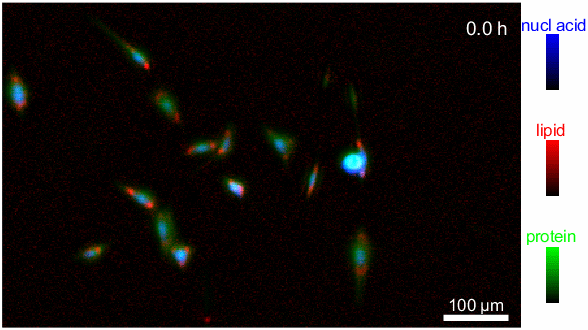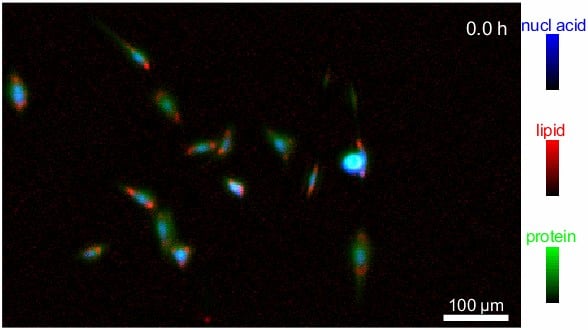Summary: NIST researchers have developed a novel infrared imaging method that allows for the observation and quantification of biomolecules in live cells, overcoming previous limitations caused by water absorption.
Estimated reading time: 7 minutes
A groundbreaking infrared imaging technique developed by researchers at the National Institute of Standards and Technology (NIST) has opened up new possibilities for observing biomolecules within living cells. This method, known as solvent absorption compensation infrared (SAC-IR) microscopy, overcomes a longstanding challenge in cellular imaging by eliminating the interference caused by water absorption.
The research team, led by NIST chemist Young Jong Lee, has successfully used this technique to measure the absolute mass of proteins and other biomolecules in individual cells over time. This advancement could accelerate progress in various fields, including drug development, cell therapy, and biomanufacturing.

Why it matters: This new imaging method provides a non-invasive way to study cellular processes in real-time, without the need for potentially harmful dyes or markers. By offering a more accurate and standardized approach to measuring biomolecules in cells, SAC-IR microscopy could lead to significant improvements in our understanding of cell biology and the development of new medical treatments.
Overcoming the Water Problem in IR Imaging
Infrared microscopy has long been a powerful tool for identifying and analyzing chemical structures in various materials. However, its application to living cells has been limited due to the strong absorption of infrared light by water, which makes up a large portion of cellular content.
Dr. Lee explains the challenge: “In the spectrum, water absorbs infrared so strongly, and we want to see the absorption spectrum of proteins through the thick water background, so we designed the optical system to uncloak the water contribution and reveal the protein signals.”
The SAC-IR technique uses a specialized optical element to compensate for water absorption, effectively removing the “noise” created by water and allowing researchers to focus on the signals from other biomolecules. This is similar to using a sun-blocking filter to see an airplane flying near the sun – by removing the overwhelming light source, the object of interest becomes visible.
Observing Cellular Processes in Real-Time
Using their custom-built IR laser microscope equipped with the SAC technique, the NIST team was able to observe fibroblast cells – cells that support the formation of connective tissue – over a 12-hour period. This extended observation allowed researchers to identify and measure various biomolecules, including proteins, lipids, and nucleic acids, during different stages of the cell cycle.
While 12 hours may seem like a long time, it’s actually a significant improvement over current alternatives. Many existing techniques require the use of large synchrotron facilities, which are not readily accessible to most researchers and have limited available time for experiments.
Implications for Biomedical Research and Industry
The ability to measure absolute quantities of biomolecules in individual living cells has far-reaching implications for both basic research and applied biotechnology. Some potential applications include:
- Cancer Cell Therapy: SAC-IR could help assess the safety and efficacy of modified immune cells used in cancer treatments. “In cancer cell therapy, for example, when cells from a patient’s immune system are modified to better recognize and kill cancer cells before being reintroduced back to the patient, one must ask, ‘Are these cells safe and effective?’ Our method can be helpful by providing additional insight with respect to biomolecular changes in the cells to assess cell health,” said Lee.
- Drug Development: The technique could accelerate drug discovery and testing by allowing researchers to measure how different cell types react to potential drug candidates at a molecular level.
- Cell Preservation: By providing detailed information about cellular composition, SAC-IR could help optimize processes for freezing and thawing cells, which is crucial for long-term cell storage in research and medical applications.
- Standardization of Cellular Measurements: The ability to quantify biomolecules consistently across different labs could lead to more reproducible results in cell biology research.
Future Directions and Challenges
While the current implementation of SAC-IR microscopy represents a significant advance, the NIST team is already looking to expand its capabilities. Future research aims to improve the accuracy of measurements for specific biomolecules like DNA and RNA.
The researchers also hope to use this technique to answer fundamental questions in cell biology, such as identifying the biomolecular signatures that correspond to different stages of cell viability. This could have important implications for fields like regenerative medicine and tissue engineering.
As with any new technology, there will likely be challenges in scaling up the SAC-IR technique for widespread use. Issues such as cost, ease of use, and integration with existing laboratory workflows will need to be addressed. However, the potential benefits of this new imaging method make it an exciting development in the field of cellular biology and biomedical research.
Quiz:
- What is the main challenge that SAC-IR microscopy overcomes in cellular imaging?
- How long were the researchers able to observe fibroblast cells using the new technique?
- Name one potential application of SAC-IR microscopy in biomedical research.
Answer Key:
- The strong absorption of infrared light by water in cells, which previously obscured other biomolecules.
- 12 hours
- Possible answers include: assessing modified immune cells for cancer therapy, drug development and testing, optimizing cell preservation methods, or standardizing cellular measurements across labs.
If our reporting has informed or inspired you, please consider making a donation. Every contribution, no matter the size, empowers us to continue delivering accurate, engaging, and trustworthy science and medical news. Independent journalism requires time, effort, and resources—your support ensures we can keep uncovering the stories that matter most to you.
Join us in making knowledge accessible and impactful. Thank you for standing with us!

